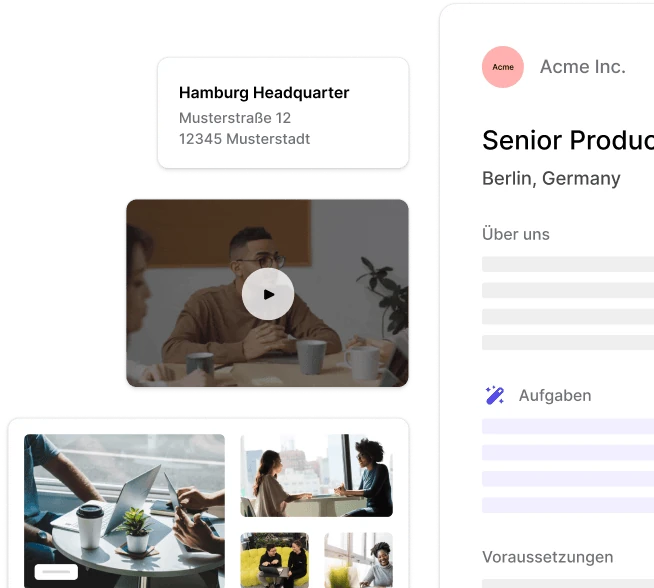Glossary: HR & Recruiting Definitions
What is a job description?
A job description, also called a position specification or summary, is a clear and unambiguous requirement profile for a position within a company. It describes the tasks, responsibilities, and competencies required for the role.
It is regarded as an important management and organisational instrument with a wide range of uses. For example, as the basis for employment contracts or performance appraisals.
Table of contents
What is the difference between a job description and a job advertisement?
Although the two terms are often used interchangeably, there are a few important differences between job descriptions and job advertisements that recruiters should be aware of.
- Job descriptions are more detailed than job ads
A job description is much more detailed and precise than an advertisement. It contains job objectives, core and secondary tasks, competencies, and a person’s superiors or subordinates.
- Job descriptions do not include qualifications
A job specification may list some general requirements (e.g. experience in a certain field), but it normally won’t mention direct qualification requirements (e.g. a degree or specific hard skills)
- Job descriptions are actually internal documents
The actual, full job description is an internal document that is not published outside the organisation. However, it is still part of a job advertisement in an abbreviated form and it’s also an important part of the subsequent confidential employment contract.
- Job descriptions say more about the position in the company
The job advertisement is mainly used to recruit new employees, but it usually says very little about the actual position within the company. The job description, on the other hand, explains the role’s position within the organisation (department, superiors, subordinates, authority, management responsibility, etc.).

What information belongs in a job description?
When preparing a job description, the first question you should ask yourself is “what belongs in a job description?” And, equally important is knowing what doesn’t belong in a job description.
Here is a brief overview of the most important elements:
- Job title
- Work location (office, hybrid, remote)
- Work model (full-time, part-time)
- Salary (range) and other benefits
- Department and function
- Objective of the job (qualitative, quantitative, developmental)
- Tasks (subdivided into core, main, and secondary tasks)
- Provided tools
- Duties and responsibilities (information, communication, etc.)
- Powers and, if applicable, authorisations
- Formal requirements
- Organisational integration
- Direct superiors and subordinates
- Participation in committees or special projects
- Substitution
- Information on performance evaluation (frequency, context, sources, etc.)
These details, on the other hand, do not belong in a job description:
- Direct requirements profile (e.g. professional qualifications)
- Personal data (e.g. gender, name, etc.)
- Internal company information
Attention:
In terms of the exact content, it’s important to keep the purpose of the job description in mind.
As the basis of the job advertisement, it makes sense to document certain qualifications in the form of hard and soft skills that are considered essential for successfully filling the position. However, this shouldn’t be anything too specific, so as not to scare off potential applicants.
An employment contract based on such a function or job description, on the other hand, must contain much more concrete and also personal data. But in this case, it does so without the information on professional qualifications.
Advantages and disadvantages of a job description
Given the detail of such a job or function description, recruiters and HR professionals naturally ask themselves about the cost-benefit ratio. Is the job description a useful and efficient tool?
Let’s have a look at the advantages and disadvantages of a job specification.
What are the advantages of a job description?
The job specification in hrm clarifies all the important issues surrounding a particular position in the company. This makes it a practical working basis. In addition, HR professionals can look forward to the following advantages of the job description.
- Makes the employee search easier
A well-developed job description gives recruiters a better idea of what they are looking for and where the focus lies (skills, competencies, objectives). This makes the search for suitable candidates much easier.
- Can be used for multiple purposes
A job description describes a function or activity rather than a person, and can therefore be used for several similar positions. This is particularly advantageous in large companies with many employees.
- Basis for other important documents
Once you have taken the trouble to create a detailed job profile, you will also benefit from it in later personnel matters. For example, a job description can be used as the basis for job advertisements, employment contracts, performance appraisals, and even for references.
- Clear regulation of powers and competencies
The written description of competencies and powers of a position, as well as the direct superiors, subordinates, and deputies within an organisation, prevents misunderstandings. This can effectively prevent power play between employees and unauthorised actions.
- Can contribute to better staff retention
Seeing one’s raison d’être in black and white and knowing one’s goals also increases employee motivation and satisfaction. This, in turn, has a positive impact on employee retention.
- More effective onboarding of new team members
With the help of a job description and job specification, new team members can also be onboarded more effectively. The clear definition of core, main, and secondary tasks enables a focussed introduction of new employees to their field of activity.
- Clearer classification at the organisational level
An organisational chart helps to depict complex corporate structures in a simple way. For this purpose, however, the employees of an organisation should be clearly defined and listed according to their position. A job description helps with that.
What are the disadvantages of a job description?
Unfortunately, a job description does also offer potential disadvantages that HR professionals should be aware of.
- Creation and maintenance is very time-consuming
Since a job description is at the same time very comprehensive and precise, its creation requires extremely thorough and extensive preparation. In addition, it consists of a lot of variables, which can lead to frequent adjustments and additions (e.g. in the case of restructuring and employee promotions).
- Can slow down dynamic developments
If a job description is too static and set in stone, it can create a kind of tunnel vision. This can slow down the associated dynamic development and cooperation among team members.
- Doesn’t reflect the diversity of modern workplace structures
A static field of activity is rare in today’s working world, and there are hardly any team members who constantly take on the same tasks. Frequently, team and project work will be assigned and new tasks or requirements are added or dropped.
Why are job descriptions important?
Creating a job description is especially useful and significant because it is much more than just a job aid. It enables companies and HR professionals to:
- Be transparent to team members at all levels
- Encourage more effective or productive ways of working
- Better monitor performance appraisals
- Have more tangible information on staffing needs and planning
Who is responsible for creating and maintaining job descriptions?
The creation and maintenance of job descriptions is generally the responsibility of a company’s Human Resources Manager.
However, in most cases this requires the support and cooperation of employees involved in the task of a vacant position (later direct supervisors). It is also advisable to obtain the approval of higher management.
Are you searching for help to create a job description for your next hire? Discover our job description templates, including data analyst job description, office manager job description, product manager job description, and many more to attract the best talents.
You still don’t know where to start posting your job ads? Check out how we can help you promote your job ads to reach more talents faster and easier.
Free recruiting software that helps you hire faster
Find out for yourself how we help you attract, screen, and manage the best talent to grow your team.
Get started for freeRelated terms


